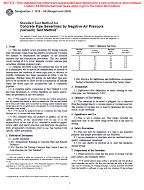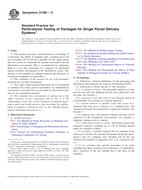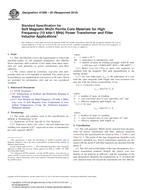Click here to purchase
1.1 This test method covers the determination of aerosol hexamethylene diisocyanate (HDI) in air samples collected from workplace and ambient atmospheres. The method described in this test method collects separate fractions. One fraction will be dominated by vapor, and the other fraction will be dominated by aerosol. It is not known at the present time whether this represents a perfect separation of vapor and aerosol, and in any case, there are not separate exposure standards for vapor and aerosol. Therefore, in comparing the results for isocyanate against a standard, results from the two fractions should be combined to give a single total value. The reason for splitting the sample into two fractions is to increase analytic sensitivity for the vapor fraction and also to give the hygienist or ventilation engineer some information concerning the likely state of the isocyanate species. The analyses of the two fractions are different, and are provided in separate, linked, standards to avoid confusion. This test method is principally used to determine short term exposure (15 min) of HDI in workplace environments for personal monitoring or in ambient air. The analysis of the vapor fraction is performed separately, as described in Test Method D6562.
1.2 Differential air sampling is performed with a segregating device. The aerosol fraction is collected on a polytetrafluoroethylene (PTFE) filter.
1.3 Immediately after sampling, the PTFE filter is transferred into a jar containing a (methoxy-2 phenyl-1) piperazine (MOPIP) solution in toluene.
1.4 The analysis of the aerosol fraction is performed by using a high performance liquid chromatograph (HPLC) equipped with an ultraviolet (UV) detector. The range of application of the test method has been validated from 0.052 to 1.04 ?g of monomeric HDI/mL, which corresponds, based on a 15 L air sample, to concentrations from 0.004 to 0.070 mg/m3 of HDI. Those concentrations correspond to a range of aerosol phase concentrations from 0.5 ppb (V) to 10 ppb (V) and cover the established threshold limit valve (TLV) value of 5 ppb (V).
1.5 The quantification limit for the monomeric HDI is 0.041 ?g per mL, which corresponds to 0.003 mg/m3 for a 15 L sampled air volume. This value is equivalent to ten times the standard deviation obtained from ten measurements carried out on a standard solution in contact with the PTFE filter whose concentration of 0.1 ?g/mL is close to the expected detection limit.
1.6 This standard does not purport to address all of the safety concerns, if any, associated with its use. It is the responsibility of the user of this standard to establish appropriate safety and health practices and determine the applicability of regulatory limitations prior to use. See Section 9 for additional hazards.
Product Details
- Published:
- 10/01/2011
- Number of Pages:
- 5
- File Size:
- 1 file , 120 KB


